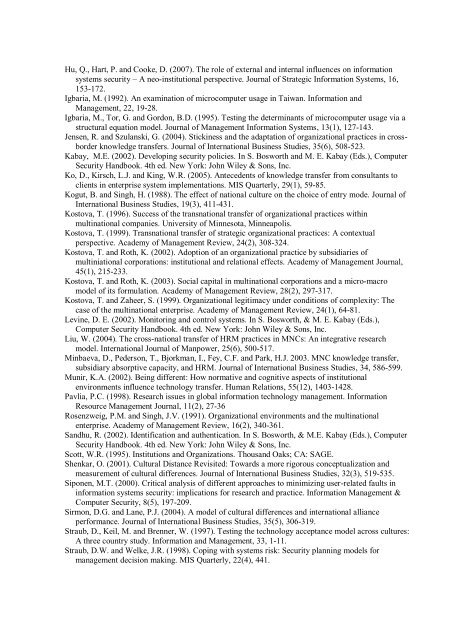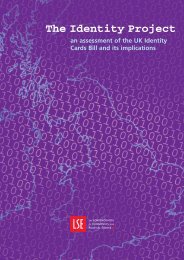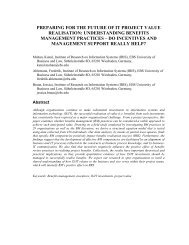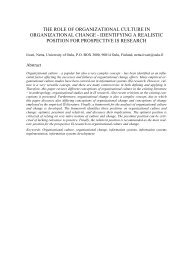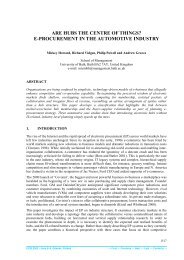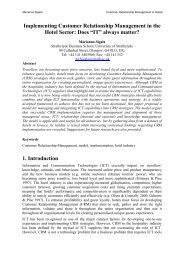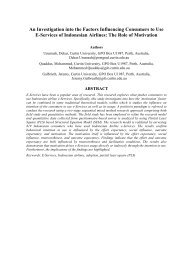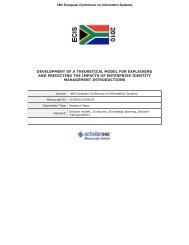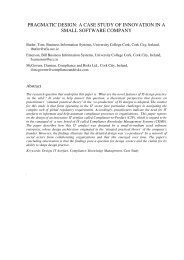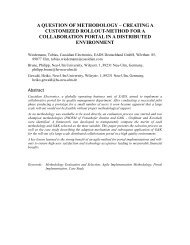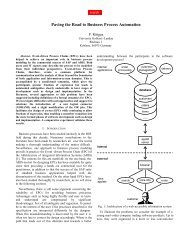enforcing information security policies through cultural boundaries
enforcing information security policies through cultural boundaries
enforcing information security policies through cultural boundaries
You also want an ePaper? Increase the reach of your titles
YUMPU automatically turns print PDFs into web optimized ePapers that Google loves.
Hu, Q., Hart, P. and Cooke, D. (2007). The role of external and internal influences on <strong>information</strong><br />
systems <strong>security</strong> – A neo-institutional perspective. Journal of Strategic Information Systems, 16,<br />
153-172.<br />
Igbaria, M. (1992). An examination of microcomputer usage in Taiwan. Information and<br />
Management, 22, 19-28.<br />
Igbaria, M., Tor, G. and Gordon, B.D. (1995). Testing the determinants of microcomputer usage via a<br />
structural equation model. Journal of Management Information Systems, 13(1), 127-143.<br />
Jensen, R. and Szulanski, G. (2004). Stickiness and the adaptation of organizational practices in crossborder<br />
knowledge transfers. Journal of International Business Studies, 35(6), 508-523.<br />
Kabay, M.E. (2002). Developing <strong>security</strong> <strong>policies</strong>. In S. Bosworth and M. E. Kabay (Eds.), Computer<br />
Security Handbook. 4th ed. New York: John Wiley & Sons, Inc.<br />
Ko, D., Kirsch, L.J. and King, W.R. (2005). Antecedents of knowledge transfer from consultants to<br />
clients in enterprise system implementations. MIS Quarterly, 29(1), 59-85.<br />
Kogut, B. and Singh, H. (1988). The effect of national culture on the choice of entry mode. Journal of<br />
International Business Studies, 19(3), 411-431.<br />
Kostova, T. (1996). Success of the transnational transfer of organizational practices within<br />
multinational companies. University of Minnesota, Minneapolis.<br />
Kostova, T. (1999). Transnational transfer of strategic organizational practices: A contextual<br />
perspective. Academy of Management Review, 24(2), 308-324.<br />
Kostova, T. and Roth, K. (2002). Adoption of an organizational practice by subsidiaries of<br />
multiniational corporations: institutional and relational effects. Academy of Management Journal,<br />
45(1), 215-233.<br />
Kostova, T. and Roth, K. (2003). Social capital in multinational corporations and a micro-macro<br />
model of its formulation. Academy of Management Review, 28(2), 297-317.<br />
Kostova, T. and Zaheer, S. (1999). Organizational legitimacy under conditions of complexity: The<br />
case of the multinational enterprise. Academy of Management Review, 24(1), 64-81.<br />
Levine, D. E. (2002). Monitoring and control systems. In S. Bosworth, & M. E. Kabay (Eds.),<br />
Computer Security Handbook. 4th ed. New York: John Wiley & Sons, Inc.<br />
Liu, W. (2004). The cross-national transfer of HRM practices in MNCs: An integrative research<br />
model. International Journal of Manpower, 25(6), 500-517.<br />
Minbaeva, D., Pederson, T., Bjorkman, I., Fey, C.F. and Park, H.J. 2003. MNC knowledge transfer,<br />
subsidiary absorptive capacity, and HRM. Journal of International Business Studies, 34, 586-599.<br />
Munir, K.A. (2002). Being different: How normative and cognitive aspects of institutional<br />
environments influence technology transfer. Human Relations, 55(12), 1403-1428.<br />
Pavlia, P.C. (1998). Research issues in global <strong>information</strong> technology management. Information<br />
Resource Management Journal, 11(2), 27-36<br />
Rosenzweig, P.M. and Singh, J.V. (1991). Organizational environments and the multinational<br />
enterprise. Academy of Management Review, 16(2), 340-361.<br />
Sandhu, R. (2002). Identification and authentication. In S. Bosworth, & M.E. Kabay (Eds.), Computer<br />
Security Handbook. 4th ed. New York: John Wiley & Sons, Inc.<br />
Scott, W.R. (1995). Institutions and Organizations. Thousand Oaks; CA: SAGE.<br />
Shenkar, O. (2001). Cultural Distance Revisited: Towards a more rigorous conceptualization and<br />
measurement of <strong>cultural</strong> differences. Journal of International Business Studies, 32(3), 519-535.<br />
Siponen, M.T. (2000). Critical analysis of different approaches to minimizing user-related faults in<br />
<strong>information</strong> systems <strong>security</strong>: implications for research and practice. Information Management &<br />
Computer Security, 8(5), 197-209.<br />
Sirmon, D.G. and Lane, P.J. (2004). A model of <strong>cultural</strong> differences and international alliance<br />
performance. Journal of International Business Studies, 35(5), 306-319.<br />
Straub, D., Keil, M. and Brenner, W. (1997). Testing the technology acceptance model across cultures:<br />
A three country study. Information and Management, 33, 1-11.<br />
Straub, D.W. and Welke, J.R. (1998). Coping with systems risk: Security planning models for<br />
management decision making. MIS Quarterly, 22(4), 441.


